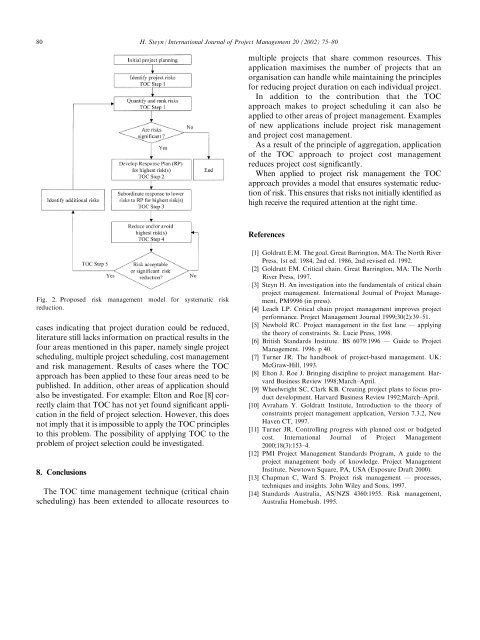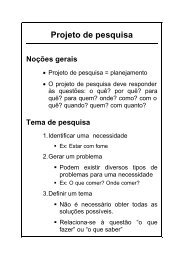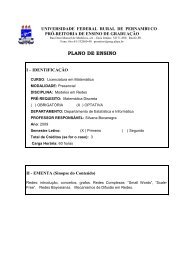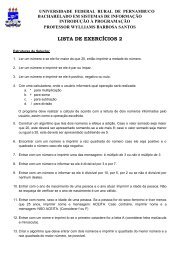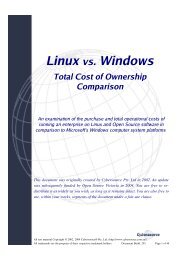Project management applications of the theory of constraints beyond ...
Project management applications of the theory of constraints beyond ...
Project management applications of the theory of constraints beyond ...
You also want an ePaper? Increase the reach of your titles
YUMPU automatically turns print PDFs into web optimized ePapers that Google loves.
80 H. Steyn / International Journal <strong>of</strong> <strong>Project</strong> Management 20 2002) 75±80multiple projects that share common resources. Thisapplication maximises <strong>the</strong> number <strong>of</strong> projects that anorganisation can handle while maintaining <strong>the</strong> principlesfor reducing project duration on each individual project.In addition to <strong>the</strong> contribution that <strong>the</strong> TOCapproach makes to project scheduling it can also beapplied to o<strong>the</strong>r areas <strong>of</strong> project <strong>management</strong>. Examples<strong>of</strong> new <strong>applications</strong> include project risk <strong>management</strong>and project cost <strong>management</strong>.As a result <strong>of</strong> <strong>the</strong> principle <strong>of</strong> aggregation, application<strong>of</strong> <strong>the</strong> TOC approach to project cost <strong>management</strong>reduces project cost signi®cantly.When applied to project risk <strong>management</strong> <strong>the</strong> TOCapproach provides a model that ensures systematic reduction<strong>of</strong> risk. This ensures that risks not initially identi®ed ashigh receive <strong>the</strong> required attention at <strong>the</strong> right time.ReferencesFig. 2. Proposed risk <strong>management</strong> model for systematic riskreduction.cases indicating that project duration could be reduced,literature still lacks information on practical results in <strong>the</strong>four areas mentioned in this paper, namely single projectscheduling, multiple project scheduling, cost <strong>management</strong>and risk <strong>management</strong>. Results <strong>of</strong> cases where <strong>the</strong> TOCapproach has been applied to <strong>the</strong>se four areas need to bepublished. In addition, o<strong>the</strong>r areas <strong>of</strong> application shouldalso be investigated. For example: Elton and Roe [8] correctlyclaim that TOC has not yet found signi®cant applicationin <strong>the</strong> ®eld <strong>of</strong> project selection. However, this doesnot imply that it is impossible to apply <strong>the</strong> TOC principlesto this problem. The possibility <strong>of</strong> applying TOC to <strong>the</strong>problem <strong>of</strong> project selection could be investigated.8. ConclusionsThe TOC time <strong>management</strong> technique critical chainscheduling) has been extended to allocate resources to[1] Goldratt E.M. The goal. Great Barrington, MA: The North RiverPress, 1st ed. 1984, 2nd ed. 1986, 2nd revised ed. 1992.[2] Goldratt EM. Critical chain. Great Barrington, MA: The NorthRiver Press, 1997.[3] Steyn H. An investigation into <strong>the</strong> fundamentals <strong>of</strong> critical chainproject <strong>management</strong>. International Journal <strong>of</strong> <strong>Project</strong> Management,PM9996 in press).[4] Leach LP. Critical chain project <strong>management</strong> improves projectperformance. <strong>Project</strong> Management Journal 1999;302):39±51.[5] Newbold RC. <strong>Project</strong> <strong>management</strong> in <strong>the</strong> fast lane Ð applying<strong>the</strong> <strong>the</strong>ory <strong>of</strong> <strong>constraints</strong>. St. Lucie Press, 1998.[6] British Standards Institute. BS 6079:1996 Ð Guide to <strong>Project</strong>Management. 1996. p 40.[7] Turner JR. The handbook <strong>of</strong> project-based <strong>management</strong>. UK:McGraw-Hill, 1993.[8] Elton J, Roe J. Bringing discipline to project <strong>management</strong>. HarvardBusiness Review 1998;March±April.[9] Wheelwright SC, Clark KB. Creating project plans to focus productdevelopment. Harvard Business Review 1992;March±April.[10] Avraham Y. Goldratt Institute, Introduction to <strong>the</strong> <strong>the</strong>ory <strong>of</strong><strong>constraints</strong> project <strong>management</strong> application, Version 7.3.2, NewHaven CT, 1997.[11] Turner JR. Controlling progress with planned cost or budgetedcost. International Journal <strong>of</strong> <strong>Project</strong> Management2000;183):153±4.[12] PMI <strong>Project</strong> Management Standards Program, A guide to <strong>the</strong>project <strong>management</strong> body <strong>of</strong> knowledge. <strong>Project</strong> ManagementInstitute, Newtown Square, PA, USA Exposure Draft 2000).[13] Chapman C, Ward S. <strong>Project</strong> risk <strong>management</strong> Ð processes,techniques and insights. John Wiley and Sons, 1997.[14] Standards Australia, AS/NZS 4360:1955. Risk <strong>management</strong>,Australia Homebush. 1995.


